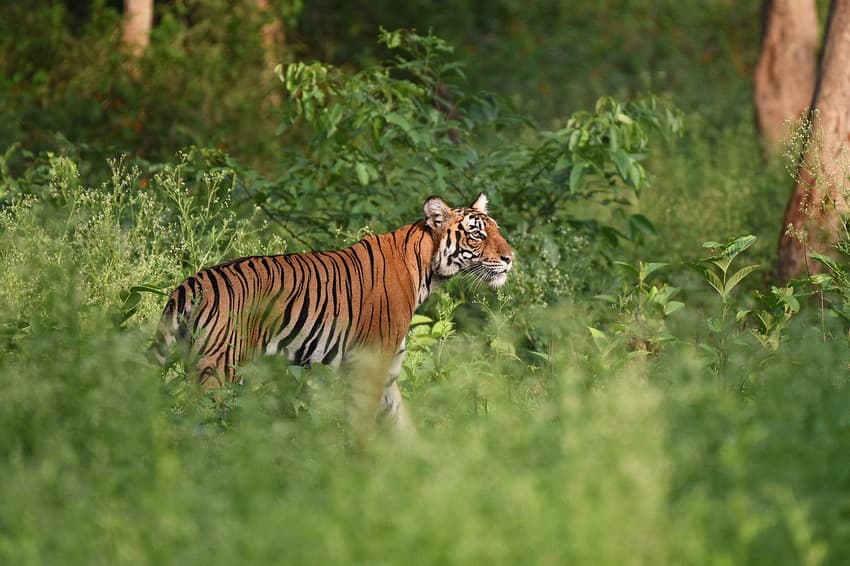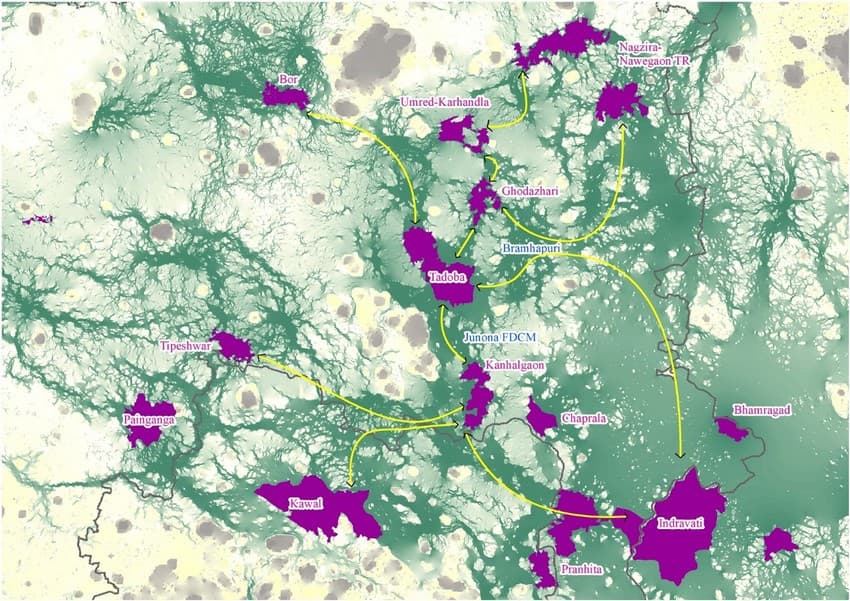In the past, tiger conservation strategies have been highly focused on addressing tiger numbers within Protected Areas. However, there is emerging evidence that increasing local tiger abundance, while important, will still be an inadequate conservation strategy in the absence of population connectivity

Photo credit: Dr. Anish Andheria
Tiger is a long-ranging species and can disperse over 650 km. between Protected Areas. One of the major limiting factors for the long-term viability of tiger populations is the availability of habitat. Studies have shown that the extinction rate of tigers in small Protected Areas can be reduced by 70 percent by securing adjacent forest areas and corridors.
This highlights the importance of landscape connectivity for the long-term survival of tigers. The future of large carnivores like tigers is in securing habitats to maintain structural and functional connectivity. The ability of tigers to inhabit new areas will be governed by the extent of anthropogenic pressures and the quality of habitat outside Protected Areas.
One such example is of the Greater Tadoba Landscape which highlights the importance of looking at tigers as a metapopulation within a larger landscape. Tadoba-Andhari Tiger Reserve (TATR) is well known for its tiger sightings and tiger-based tourism. However, the surrounding forest areas of Bramhapuri and Central Chanda play a key role in the tiger-population dynamics within TATR. These surrounding forest blocks outside Protected Areas support a resident breeding population of tigers and tigers disperse to TATR from these forest blocks. Similarly, tigers disperse out of TATR to other forest areas through corridors that facilitate tiger movement.

Map depicting tiger connectivity between Protected Areas in the Greater Tadoba Landscape. Credit: WCT
Discounting these surrounding forest areas (Bramhapuri and Central Chanda Forest Blocks) and the corridors connecting TATR to other Protected Areas will hamper the tiger population in TATR in the long run. These corridors are under immense anthropogenic pressures mainly due to large scale fuel-wood extraction which leads to habitat degradation and increases the frequency of human-tiger interactions which many a times manifests into conflict.
With the onset of tendu leaves collection season, hundreds of hectares of forests are set afire. Forest fires affect regeneration and understorey vegetation which in turn impacts wild herbivore populations. Diversion of forest areas for mines and irrigation projects (dams and canals) leads to fragmentation and reduction of already scarce habitat for wildlife. Development activities like the upgradation of roads and railway lines lead to animal deaths and hamper the safe passage of wildlife between forest patches. Avoiding development projects in forest areas is essential. Upgradation of existing projects must be inclusive of ecologically meaningful mitigation measures to address the negative impacts on wildlife and forests.
In recent years, efforts have been made to declare new Protected Areas which are critical links between TATR and other Protected Areas. The Ghodazhari Wildlife Sanctuary is a key stepping stone between TATR and Umred-Karhandla-Pauni Wildlife Sanctuary, further connecting to the Nagzira-Nawegaon Tiger Reserve. Similarly, the Kanhalgaon Wildlife Sanctuary is a critical link between TATR and Kawal Tiger Reserve in Telangana. Kanhalgaon has provided the founding population of tigers to forest areas in Telangana. With tigers dispersing from Kanhalgaon, this forest block has been crucial in boosting the tiger population in the neighbouring states of Telangana and Chhattisgarh.
Safeguarding such large forest blocks within corridors further enhances the tiger connectivity in a landscape. Increasing tiger populations is one goal that cannot be achieved without protecting corridors. There are several large forest blocks in Vidarbha that can be upgraded to Protected Areas which will boost wildlife populations and at the same time provide livelihoods to locals through tourism. The need of the hour is to manage tiger bearing forest areas outside Protected Areas with a focus on wildlife conservation rather than timber production.
Since many forest divisions in Vidarbha support resident breeding populations of tigers, an increased focus on tiger habitats outside Protected Areas is imperative.
This article was originally published in the Maharashtra Times in Marathi.
——————————————————————————————————————————————————————
About the author: Aditya Joshi is a wildlife biologist and heads the Conservation Research division of the Wildlife Conservation Trust. He is also a member of the IUCN SSC Pangolin Specialist Group as well as the IUCN WCPA Connectivity Conservation Specialist Group.
Disclaimer: The author is associated with Wildlife Conservation Trust. The views and opinions expressed in the article are his own and do not necessarily reflect the views and opinions of Wildlife Conservation Trust.
——————————————————————————————————————————————————————
Your donations support our on-ground operations, helping us meet our conservation goals.
——————————————————————————————————————————————————————
Related Links
- Monitoring Tigers Beyond Tiger Reserves
- Rise in Wildlife Crime: Pandemic’s Intensifying Collateral Damage
- The Curious Case of India’s Wildlife Corridors
- Facilitating wild felid conservation
- 2016 wins the race for – “The Hottest Year on Record”

